Ijraset Journal For Research in Applied Science and Engineering Technology
- Home / Ijraset
- On This Page
- Abstract
- Introduction
- Conclusion
- References
- Copyright
Improving Gas Turbine Efficiency through Ribbed Channel Designs: A CFD-Based Study
Authors: Shantanu Shanu Singh Parmar, Gouraw Beohar, Dr. Shailesh Gupta
DOI Link: https://doi.org/10.22214/ijraset.2023.54783
Certificate: View Certificate
Abstract
In order to increase performance and efficiency, this research article investigates the usage of ribbed channels in gas turbines. It uses computational fluid dynamics (CFD) simulations to assess various rib shapes and attack angles and evaluate the thermal-hydraulic performance of ribs. According to the results, square-shaped ribs consistently perform better than alternative rib geometries in terms of efficiency, normalized skin friction coefficient ratio, and skin friction coefficient ratio. The work emphasizes how crucial metal temperature prediction is in gas turbine blades and vanes because of the complex interaction between fluid dynamics and flow. The results may be used to establish and optimize cooling plans for increased gas turbine performance and efficiency.
Introduction
I. INTRODUCTION
Gas turbines are essential in today's industrialised world for supplying the rising energy and electricity needs. Over the past fifty years, efficient cooling strategies have been used to increase thermal efficiency and power production. Gas turbine parts with smooth passageways to complicated geometries with unique surfaces and fluid-surface interactions have all been cooled using single-phase gas internal convection. Maximising the total cooling effect while reducing the influence of the thermodynamic power cycle is the main goal.
A high-pressure turbine receives 20% to 30% of compressed air at 650°C from the compressor, which can lower the blades' temperature to around 1000°C for safe engine operation. Innovative key technologies are required for high-temperature turbine blade cooling methods. Predicting metal temperatures for blades and vanes is essential during the design phase to reduce product development cycle time and predict blade and blade life. The intricate flow around the blades and vanes makes it difficult to predict metal temperatures.
Collecting data on hot gas path heat transfer distribution and film cooling data is essential for air foils. Factors such as combustor's high turbulence, acceleration, laminar-to-turbulent transition, film cooling flow, platform secondary flow, and surface roughness all impact vane surface heat transfer. Additionally, factors like leakage, blade tip clearance, and forces like centrifugal and rotational forces must be considered.
Identifying hot spots in the surface of blades and vanes of gas turbines can improve turbine and blade cooling performance. Innovative and new heat transfer data can help identify hot spots and enhance the overall efficiency of gas turbines.
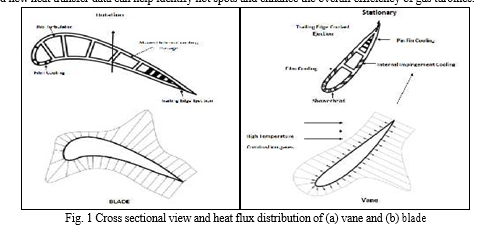
Numerous methods have been developed to improve heat transfer in turbine blades and vanes. Jet impingement, film cooling, pin ribs, dimples, and trailing edge potion are used to cool passages in the air foil's center. Combining conventional cooling methods ensures adequate cooling of blades and vanes. Understanding flow physics is crucial for effective cooling. In 2021, Liu, Hussain, Wang and colleagues conducted an experimental study using liquid crystal thermography (LCT) to measure the surface temperature of a rectangular cooling channel with 90° perforated ribs.
Zhu, Chang, Chen and others (2020) used computational fluid dynamics (CFD) to study the effect of channel geometry on a microchannel heat sink with rectangular grooves and ribs using Fluent software. Sharma, Tariq and colleagues used numerical simulation and experimental methods such as ANSYS ICEM, LCT and commercial FLUENT software to model the flow field, turbulence and surface temperature distribution in the ribs channel. Experimental studies by Alfarawi, Abdel-Moneim (2017) and Singh, Ekkad (2017) investigated heat transfer and flow friction in rectangular ducts with various ribs geometries using a dedicated test rig and liquid crystal thermography. Numerical simulations using CFD and Fluent software by Zheng, Wang (2019), Xie, Liu, Yan (2017), Navaei, Mohammed, Munisamy, Yarmand, Gharehkhani (2015), Kamali, Binesh (2008) carried out by various researchers such as Analyze fluid flow, heat transfer properties, and pressure drop in ribsned channels and micro heat sinks.Other methods used in the reviewed studies include transient heat transfer experiments, numerical investigations and custom-made software.
A. Introduction About Rib Turbulent Cooling
Ribs are turbulence promoters placed in pressure and suction sides of internal cooling passages to enhance heat transfer in blades and vanes of advanced gas turbines. These ribs adapt to external loads and isolate fluid stream lines, allowing flow separation and reattachment, as shown in Figure 2.
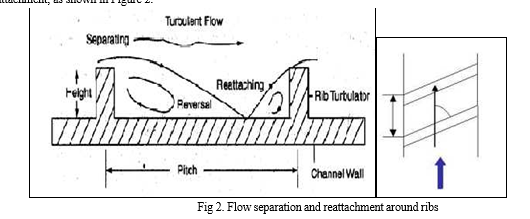
Separation and reattachment increase the flow's turbulence and disturb the boundary layer. This combines cooler elements in the middle of the flow with liquid elements near the walls. Improved heat transfer is caused by two phenomena.
Conduction moves heat from the outer pressure and suction sides of the turbine blades into the inner zone. Internal cooling removes this heat. Most of the time, internal cooling channels are modelled as small sized square or rectangular channels with different aspect ratios. The heat transfer coefficient is influenced by a number of geometric parameters, according to numerous studies. These parameters include the rib's angle of attack, inter-rib placement, rib’s pitch to rib’s height ratio, aspect ratio and block ratio.
In numerous applications, such as compact heat exchangers and gas turbine cooling systems, regular ribs are frequently used in various ducts to enhance the heat transfer process. The thermal and hydraulic performance of these channels is significantly affected by the configurations of these ribs. Due to the improved longitudinal secondary flow, angled ribs outperform vertical ribs in terms of heat transfer and pressure loss. The ribs used in this study have three distinct cross-sections and three distinct rib attack angles—35°, 45°, and 55°. Additionally, the base paper (Liu et al., 2015) and the results of the computational fluid dynamics (CFD) results can be utilized routinely during the design phase to assist in the prediction of sheet performance. This work makes use of a rectangular channel with a 5-aspect ratio (AR). It is assumed that pitch to rib height (P/e) is 10. The experiment's Reynolds numbers fall into the turbulent range and steady state is used for this experiment.
B. Basics of Turbine Cooling
Gas turbine operation is unintentionally impacted by cooling, despite its necessity.
- The compressor discharges cooling air directly to the vanes and blades. As a result, less mass of air is entering into the combustion chamber.
- To distinguish between various structures like cooling channels, ribs, and so on, the turbine blade must have a thicker trailing edge, but it has a negative impact on its aerodynamic performance.
- Different cooling methods are used for different parts of the blade. Typically, the front, also known as the leading edge, is cooled by impingement. Typically, serpentine passages with ribs and localized film cooling are used to cool the central section. Impingement and film cooling are typically used to cool the rear portion, which is referred to as the trailing edge.
C. Types of Cooling
There are two broad categories of cooling used in gas turbine blades.
- Internal cooling.
- External cooling.
Types of internal cooling
Over the course of time, numerous variations of internal cooling have been developed. There is no one cooling method that works well for all blades and vanes in all applications. As a result, the cooling scheme should be selected in accordance with the application's requirements and operating conditions.
- Impingement Cooling: Impingement cooling is commonly referred to as impingement cooling due to the placement of the cooling air jets close to the leading edge of the airfoil that is impacting the inside surface of the blade. The middle of the blades and vanes can also be cooled with these methods. The surface area of blades and vanes, the size and distribution of the jet holes and the cross section of the cooling channels all of these factors will influence the heat transfer properties of this cooling method.
- Pin Ribs Cooling: This method is known as pin ribs cooling because the blade's trailing edge is so narrow that it is hard to machine holes or passages there, that’s why pin ribs cooling is often used in this area. The flow around a cylinder and a pin are similar. The wake is dumped downstream as the airflow splits. Additionally, horseshoe-shaped vortices that wrap around the ribs are formed, enhancing heat transfer and facilitating additional mixing. The types of rib array, pin spacing within the array, shape and size of pin all have a significant impact on the properties of heat transfer.
- Dimple Cooling: This kind of cooling happens because of the presence of dents or dimples on the surface of the vanes and blades of gas turbine. They improve heat transfer by causing flow separation and reattachment. Because of its low pressure drop, it is a highly desirable refrigeration technology.
- Turbulent Cooling of Ribs: The use of turbulence-enhancing structures in the walls of the air-foil's cooling passages, which are cast with the air-foil during manufacturing, is necessary for this type of cooling of ribs. Heat travels through the blade wall to the coolant that flows inside the blade. The coolant flow's Reynolds number, the configuration of the ribs, and the aspect ratio of the channel all have a significant impact on the characteristics of heat transfer. This study investigates the coefficient of friction, Nusselt number, ribbed channel Nusselt number, ribbed channel friction coefficient, and thermal-hydraulic coefficients for different rib sections and attack angles in 2000 Reynolds numbers. It also examines the ratio of ribbed channel friction coefficient to smooth channel friction coefficient, and thermal-hydraulic coefficients for different rib sections and attack angles. The results provide valuable insights into the behavior of ribs in various situations.
D. Equations Relating to Fluid Motion
The continuity and momentum equations, which are used to describe the conservation of mass and momentum, are the two primary types of equations used to describe the flow of fluids. Momentum equations are more commonly referred to as the Navier-Stokes equations. A different set of equations are used to represent energy conservation for flows with heat transfer. The continuity equation is created by applying the law of conservation of mass to a small fluid differential volume. Three equations of the following form are found in Cartesian coordinates: [Ansys fluent user guide page No. 264

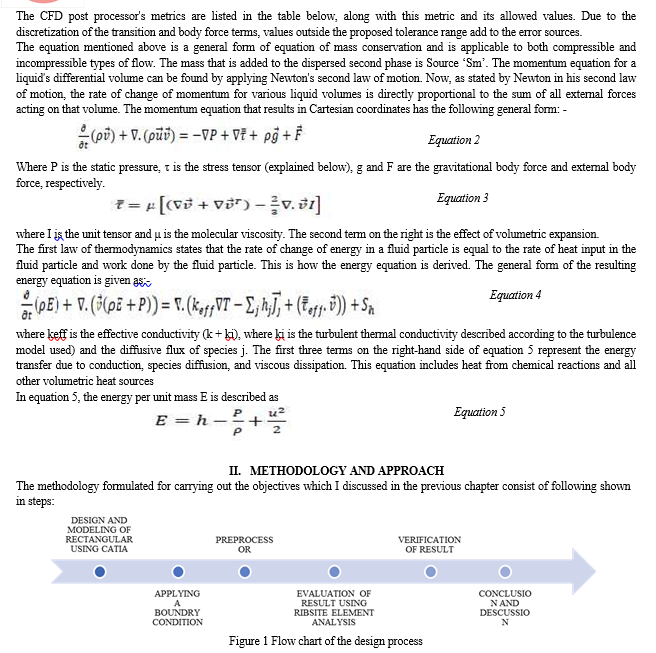
A. Methodology and CFD Governing Equation
A rectangular duct with a rectangular cross-section of 200 x 40 mm2 and a duct length of 550 mm was considered in this study. The bottom of the square duct is provided with an aluminium plate with 10 ribs along the surface of the square duct. 3 different rib attack angles 35°, 45° and 55° and 3 different rib cross section shapes are used. The cross-sectional area of ??each model is the same and is equal to 4 mm² for each individual model and that the underside of the panel is kept under a uniform heat flux of 1000 W/m2. The air was passed through the duct at various Reynolds numbers from 8000 to 18000 in 2000 steps with their corresponding velocities ranging from 1.77 m/s to 3.98 m/s in 6 steps.
B. Physical Models
In this study, a rectangular duct with a length (L) of 550 mm, a width (W) of 200 mm, and a height (H) of 38 mm is included in the analysis. The hydraulic diameter (Dh) of each channel is 66 mm. A plate with numerous ribs is provided at the bottom of the rectangular duct. Various models of rectangular ducts have been produced, each with different rib cross-sections and rib attack angles. Rib attack angle for individual models should be 35°.45° and 55° with a zigzag gap in the rib path. (Liu et al., 2018; Singh & Ekkad, 2017; N. Zheng et al., 2015)

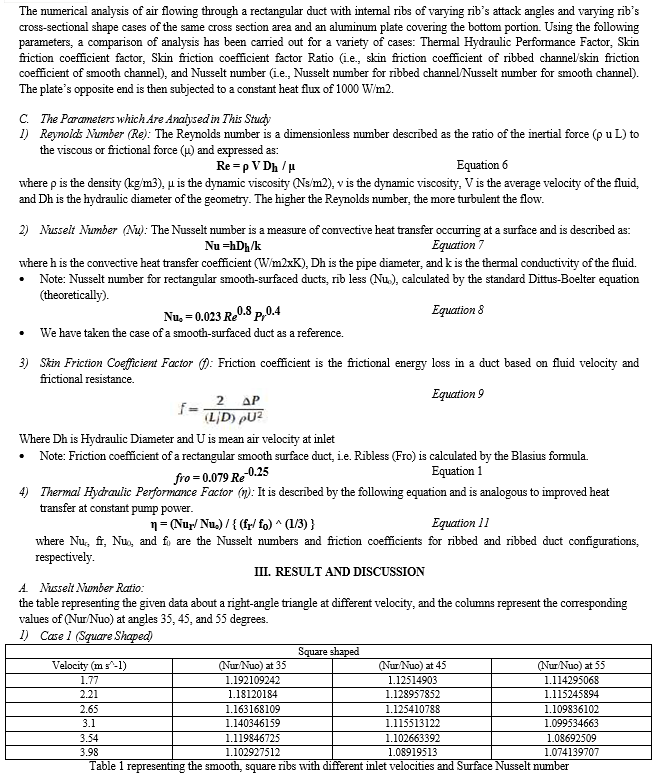

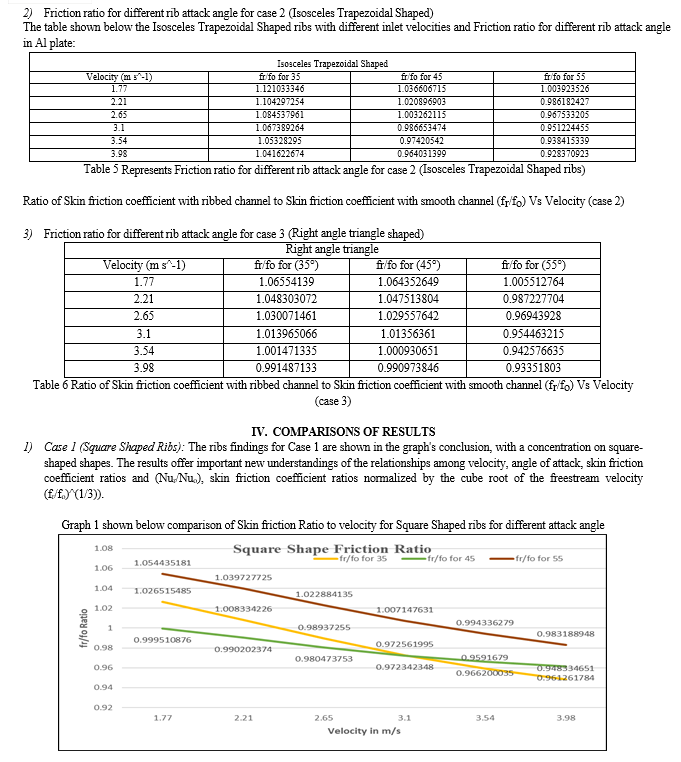
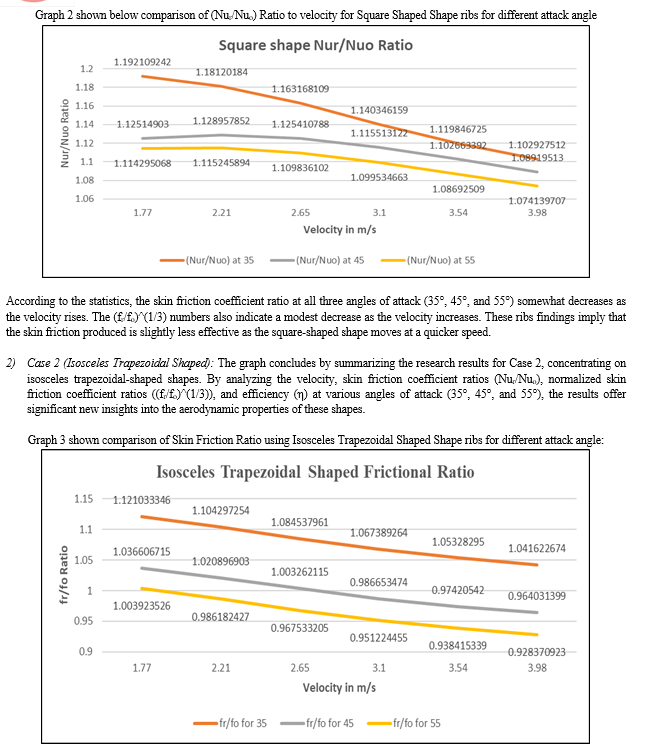

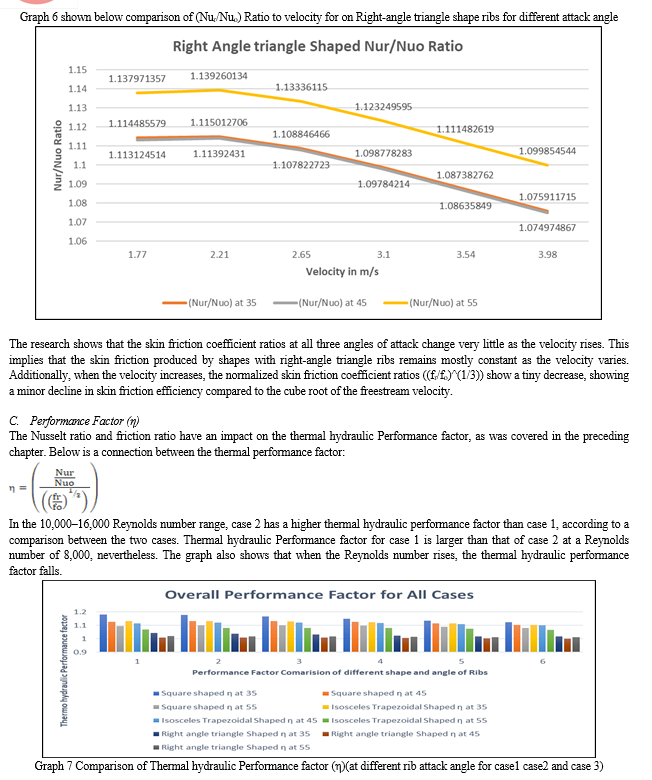
Conclusion
A comprehensive analysis of results for different cases reveals the most important results and observations for each case. 1) For case 1, a square object, analysis shows that the ratio of normalized downward velocity (Nur/ Nuo) at different angles (35°, 45°, 55°) decreases as velocity increases. is shown. Similarly, the value of (fr/fo)^(1/3) also decreases with increasing speed. The value of ?, which represents efficiency, also decreases as speed increases. 2) A similar trend is observed in case 2, observing an isosceles trapezoidal object. The (Nur/ Nuo) ratio decreases with increasing velocity, and so do the values of (fr/fo)^(1/3) and ?. However, the (Nur/Nuo) values remained constant at various angles, suggesting that the shape of the object does not significantly affect the downstream velocity. 3) In Case 3, a right-triangular object, the (Nur/ Nuo) ratio decreases with increasing velocity, as in the previous case. The values of (fr/fo)^(1/3) and ? also decrease with increasing velocity. Again, object geometry does not seem to have a significant effect on downstream velocity. Overall, the analysis found that increasing velocity decreased downstream velocity and also decreased object efficiency. Object shape has little effect on these trends. These results provide valuable insight into the hydrodynamics of different bodies at different velocities. a) Results Findings More focus on Some comparisons can be made when analysing the results for all three cases: square, isosceles trapezoid, and right triangle objects. b) Regarding the skin friction coefficient ratio (Nur/Nuo), the square object always shows higher values than the other two cases, even at different velocities and angles of attack. c) This suggests that square objects are more capable of generating skin friction under the conditions tested. d) Considering the normalized skin friction coefficient ratio (fr/fo^(1/3)), square bodies always have higher values than isosceles, trapezoids and right triangles. e) This indicates that the square body has a higher skin friction efficiency than the cube root of the free stream velocity. f) In terms of overall efficiency (?), square bodies consistently achieve higher efficiency values compared to isosceles, trapezoids, and right-triangular bodies. g) This suggests that square objects are more efficient at converting input energy into usable skin friction. h) Based on a comparison of the three cases, square objects consistently outperform other shapes in terms of Skin friction coefficient ratio, normalized skin friction coefficient ratio, and efficiency. Therefore, square objects are considered to be the best results among the shapes tested in this study. However, it is important to note that these conclusions are based on certain conditions and assumptions of our analysis. This leads to the conclusion that a channel\'s thermal hydraulic performance factor is higher when the rib attack angle is lower.
References
[1] Alfarawi, S., Abdel-Moneim, S. A., & Bodalal, A. (2017). Experimental investigations of heat transfer enhancement from rectangular duct roughened by hybrid ribs. International Journal of Thermal Sciences, 118, 123–138. https://doi.org/10.1016/j.ijthermalsci.2017.04.017 [2] Aljibory, M., Lafta Rashid, F., Qahtan, H., Wahhab AL-Jibory, M., & Qahtan Hussein, H. (n.d.). Review Of Heat Transfer Enhancement In Air-Cooled Turbine Blades Heat transfer enhancement in ducts View project Natural gas industry View project Review Of Heat Transfer Enhancement In Air-Cooled Turbine Blades. www.ijstr.org [3] Chung, H., Park, J. S., Park, S., Choi, S. M., Rhee, D. H., & Cho, H. H. (2015). Augmented heat transfer with intersecting rib in rectangular channels having different aspect ratios. International Journal of Heat and Mass Transfer, 88, 357–367. https://doi.org/10.1016/j.ijheatmasstransfer.2015.04.033 [4] Ghani, I. A., Sidik, N. A. C., Mamat, R., Najafi, G., Ken, T. L., Asako, Y., & Japar, W. M. A. A. (2017). Heat transfer enhancement in microchannel heat sink using hybrid technique of ribs and secondary channels. International Journal of Heat and Mass Transfer, 114, 640–655. https://doi.org/10.1016/j.ijheatmasstransfer.2017.06.103 [5] Kamali, R., & Binesh, A. R. (2008). The importance of rib shape effects on the local heat transfer and flow friction characteristics of square ducts with ribbed internal surfaces. International Communications in Heat and Mass Transfer, 35(8), 1032–1040. https://doi.org/10.1016/j.icheatmasstransfer.2008.04.012 [6] Lee, E., Wright, L. M., & Han, J.-C. (2003). GT2003-38900 HEAT TRANSFER IN ROTATING RECTANGULAR CHANNELS (AR = 4:1) WITH V-SHAPED AND ANGLED RIB TURBULATORS WITH AND WITHOUT GAPS. Power for Land. http://www.asme.or [7] Lee, E., Wright, L. M., & Han, J. C. (2005). Heat transfer in rotating rectangular channels with V-shaped and angled ribs. Journal of Thermophysics and Heat Transfer, 19(1), 48–56. https://doi.org/10.2514/1.9065 [8] Liu, J., Hussain, S., Wang, J., Wang, L., Xie, G., & Sundén, B. (2018). Heat transfer enhancement and turbulent flow in a high aspect ratio channel (4:1) with ribs of various truncation types and arrangements. International Journal of Thermal Sciences, 123, 99–116. https://doi.org/10.1016/j.ijthermalsci.2017.09.013 [9] Liu, J., Hussain, S., Wang, W., Wang, L., Xie, G., & Sundén, B. (2019). Heat transfer enhancement and turbulent flow in a rectangular channel using perforated ribs with inclined holes. Journal of Heat Transfer, 141(4). https://doi.org/10.1115/1.4042841 [10] Liu, J., Hussain, S., Wang, W., Xie, G., & Sundén, B. (2021). Experimental and numerical investigations of heat transfer and fluid flow in a rectangular channel with perforated ribs. International Communications in Heat and Mass Transfer, 121. https://doi.org/10.1016/j.icheatmasstransfer.2020.105083 [11] Liu, J., Xie, G., & Simon, T. W. (2015). Turbulent flow and heat transfer enhancement in rectangular channels with novel cylindrical grooves. International Journal of Heat and Mass Transfer, 81, 563–577. https://doi.org/10.1016/j.ijheatmasstransfer.2014.10.021 [12] Lu, B., & Jiang, P. X. (2006). Experimental and numerical investigation of convection heat transfer in a rectangular channel with angled ribs. Experimental Thermal and Fluid Science, 30(6), 513–521. https://doi.org/10.1016/j.expthermflusci.2005.09.007 [13] Maurer, M., von Wolfersdorf, J., & Gritsch, M. (2007). An experimental and numerical study of heat transfer and pressure loss in a rectangular channel with v-shaped ribs. Journal of Turbomachinery, 129(4), 800–808. https://doi.org/10.1115/1.2720507 [14] Moon, M. A., Park, M. J., & Kim, K. Y. (2014). Evaluation of heat transfer performances of various rib shapes. International Journal of Heat and Mass Transfer, 71, 275–284. https://doi.org/10.1016/j.ijheatmasstransfer.2013.12.026 [15] Navaei, A. S., Mohammed, H. A., Munisamy, K. M., Yarmand, H., & Gharehkhani, S. (2015). Heat transfer enhancement of turbulent nanofluid flow over various types of internally corrugated channels. Powder Technology, 286, 332–341. https://doi.org/10.1016/j.powtec.2015.06.009 [16] Peng, W., Jiang, P. X., Wang, Y. P., & Wei, B. Y. (2011). Experimental and numerical investigation of convection heat transfer in channels with different types of ribs. Applied Thermal Engineering, 31(14–15), 2702–2708. https://doi.org/10.1016/j.applthermaleng.2011.04.040 [17] Qahtan Hussein, H., Wahhab Al-Jibory, M., & Lafta Rashid, F. (n.d.). Heat Transfer Enhancement of Gas Turbine Blades Using Coated Ribs with Nanocomposite Materials. In Journal of Mechanical Engineering Research and Developments (Vol. 43, Issue 6). [18] Sharma, N., Tariq, A., & Mishra, M. (2019). Experimental Investigation of Heat Transfer Enhancement in Rectangular Duct with Pentagonal Ribs. Heat Transfer Engineering, 40(1–2), 147–165. https://doi.org/10.1080/01457632.2017.1421135 [19] Singh, P., & Ekkad, S. (2017). Experimental study of heat transfer augmentation in a two-pass channel featuring V-shaped ribs and cylindrical dimples. Applied Thermal Engineering, 116, 205–216. https://doi.org/10.1016/j.applthermaleng.2017.01.098 [20] Singh, P., Pandit, J., & Ekkad, S. V. (2017). Characterization of heat transfer enhancement and frictional losses in a two-pass square duct featuring unique combinations of rib turbulators and cylindrical dimples. International Journal of Heat and Mass Transfer, 106, 629–647. https://doi.org/10.1016/j.ijheatmasstransfer.2016.09.037 [21] Tanda, G. (2004). Heat transfer in rectangular channels with transverse and V-shaped broken ribs. International Journal of Heat and Mass Transfer, 47(2), 229–243. https://doi.org/10.1016/S0017-9310(03)00414-9 [22] Wang, J., Liu, J., Wang, L., Sundén, B., & Wang, S. (2018). Numerical investigation of heat transfer and fluid flow in a rotating rectangular channel with variously-shaped discrete ribs. Applied Thermal Engineering, 129, 1369–1381. https://doi.org/10.1016/j.applthermaleng.2017.09.142 [23] Wright, L. M., Fu, W.-L., & Han, J.-C. (n.d.). THERMAL PERFORMANCE OF ANGLED, V-SHAPED, AND W-SHAPED RIB TURBULATORS IN ROTATING RECTANGULAR COOLING CHANNELS (AR = 4:1). http://www.asme.org/about-asme/terms-of-use [24] Xia, G., Zhai, Y., & Cui, Z. (2013). Numerical investigation of thermal enhancement in a micro heat sink with fan-shaped reentrant cavities and internal ribs. Applied Thermal Engineering, 58(1–2), 52–60. https://doi.org/10.1016/j.applthermaleng.2013.04.005 [25] Xie, G., Liu, X., Yan, H., & Qin, J. (2017). Turbulent flow characteristics and heat transfer enhancement in a square channel with various crescent ribs on one wall. International Journal of Heat and Mass Transfer, 115, 283–295. https://doi.org/10.1016/j.ijheatmasstransfer.2017.07.012 [26] Zhai, Y. L., Xia, G. D., Liu, X. F., & Li, Y. F. (2014). Heat transfer in the microchannels with fan-shaped reentrant cavities and different ribs based on field synergy principle and entropy generation analysis. International Journal of Heat and Mass Transfer, 68, 224–233. https://doi.org/10.1016/j.ijheatmasstransfer.2013.08.086 [27] Zheng, D., Wang, X., & Yuan, Q. (2019a). Numerical investigation on the flow and heat transfer characteristics in a rectangular channel with V-shaped slit ribs. Infrared Physics and Technology, 101, 56–67. https://doi.org/10.1016/j.infrared.2019.06.004 [28] Zheng, D., Wang, X., & Yuan, Q. (2019b). The flow and heat transfer characteristics in a rectangular channel with convergent and divergent slit ribs. International Journal of Heat and Mass Transfer, 141, 464–475. https://doi.org/10.1016/j.ijheatmasstransfer.2019.06.060 [29] Zheng, N., Liu, P., Shan, F., Liu, Z., & Liu, W. (2016). Effects of rib arrangements on the flow pattern and heat transfer in an internally ribbed heat exchanger tube. International Journal of Thermal Sciences, 101, 93–105. https://doi.org/10.1016/j.ijthermalsci.2015.10.035 [30] Zheng, N., Liu, W., Liu, Z., Liu, P., & Shan, F. (2015). A numerical study on heat transfer enhancement and the flow structure in a heat exchanger tube with discrete double inclined ribs. Applied Thermal Engineering, 90, 232–241. https://doi.org/10.1016/j.applthermaleng.2015.07.009 [31] Zhu, Q., Chang, K., Chen, J., Zhang, X., Xia, H., Zhang, H., Wang, H., Li, H., & Jin, Y. (2020). Characteristics of heat transfer and fluid flow in microchannel heat sinks with rectangular grooves and different shaped ribs. Alexandria Engineering Journal, 59(6), 4593–4609. https://doi.org/10.1016/j.aej.2020.08.014
Copyright
Copyright © 2023 Shantanu Shanu Singh Parmar, Gouraw Beohar, Dr. Shailesh Gupta. This is an open access article distributed under the Creative Commons Attribution License, which permits unrestricted use, distribution, and reproduction in any medium, provided the original work is properly cited.

Download Paper
Paper Id : IJRASET54783
Publish Date : 2023-07-14
ISSN : 2321-9653
Publisher Name : IJRASET
DOI Link : Click Here
 Submit Paper Online
Submit Paper Online

